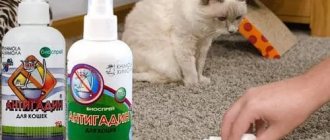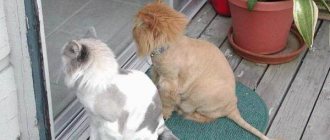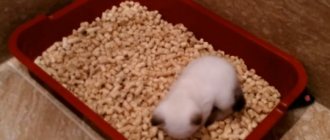Where a cat lives, there is often an unpleasant smell from the litter box. If the owners are not at home during the day, it is impossible to clean the cat litter box on time. As a result, both the animal and its owners suffer from the smell of sewage in the apartment. How to forget forever about what a dirty litter tray is? How to save tens of thousands of rubles a year on cat litter?
Using a special training system, you can teach your pet to relieve itself in the toilet. This training stand is sold in veterinary stores. “Teachers” come in different sizes and designs. How to choose the right one?
When is it easier to toilet train a cat?
It is easier to teach a cat to use the toilet as an adult, since a small kitten may not be able to stay on the slippery toilet seat.
Learning this difficult skill will take a lot of time, so you should be patient. There are two ways to train a cat to use the toilet:
- Using a regular cat litter box.
- Using special simulators sold in pet stores.
Training using simulators
Special devices for toilet training a cat are sold in pet stores.
The use of special simulators is the simplest way to train a cat to use the toilet. Pet stores sell cat toilet attachments in which a hole is gradually cut into an increasingly larger circle, gradually through the learning process.
At the initial stage of training, the simulator is used as a standard cat litter box. Filler is poured into it, placed next to the toilet and shown to the pet. The usual familiar tray, in this case, is removed. They do this so that the cat gets used to the new toilet. After 3–5 days, the simulator is put on the toilet.
Once the cat gets used to the new hole, it is necessary to cut the next one.
When the cat begins to look for a place for the toilet, they put her on the toilet, thereby showing her a new place for the toilet. When the cat gets used to it a little and begins to jump on the toilet, the first hole is cut in the simulator. Special attachments already have cutting zones, so cutting a hole will not be difficult. After the pet gets used to the new hole, the next one is cut. It is necessary to repeat the process until the nozzle is level with the toilet. Then the nozzle must be removed. And the owner and the cat will start using the same toilet.
Litter box training
Using a litter box to train a cat to use a litter box is not easy, but it's worth it!
It is necessary to move the cat's litter box to the toilet next to the toilet. The door to the bathroom should always be slightly open so that the cat can get used to the new place of her toilet. The cat should get used to the new environment and calmly go to the toilet when needed.
After completely getting used to the new place of the tray, you should start placing magazines or something flat of medium thickness under it. This should be repeated day after day until the level of the tray is equal to the level of the toilet seat.
Of course, you should pay attention to the cat’s behavior; if he doesn’t like a certain height, then placing the next magazine should be postponed until the cat gets used to it
Under no circumstances should you force or force a cat to use a new toilet. Otherwise, the animal may start shitting anywhere. The pet should gradually get used to the new toilet.
Adviсe
When the task has been completed and the cat has begun to use the toilet properly, it is important to consolidate the result. Here are some useful tips:
- the door to the toilet room should be left ajar or a special entrance hatch should be made in it;
- the lid is not lowered so that he can recover at any time.
We must not forget about rewarding your pet for correct behavior. It will not be difficult for the owner to pet his pet once again and give him his favorite treat.
Tray learning process
In order for a cat to calmly relieve itself on the toilet, you need to spend time developing a habit. You can start teaching a kitten in your apartment to go to the toilet; adults can also be trained.
- At the first stage, you should definitely move the tray to the toilet if it was in a different place. The cat will get used to the room, to the sound of water being flushed in the toilet.
- The tray gradually moves closer to the toilet, and gradually rises above the floor level. The stand for the product must be strong and stable. You need to lift the container without haste, so as not to alarm the animal.
- Over time, the tray with the filler will end up at the level of the toilet. After the pet gets used to the changes, the process of reducing the litter in the tray begins. This should be done carefully; an adult cat will immediately be frightened by the difference in the litter box.
- Is your cat already calmly walking into an empty litter tray? The next stage can begin. The container is installed directly on the toilet; it must be well secured. The animal will need to jump on the plumbing to use the toilet; an unstable tray can scare it away and ruin the entire learning process.
- After the cat has calmly climbed onto the tray installed on the toilet, you can try to completely remove the container. If the cat does not accept the innovation and refuses to relieve itself in the toilet hole, the tray is returned temporarily.
ATTENTION! You should teach your cat good habits slowly, encouraging him with a kind word for each achievement. Placing the tray on the toilet seat is not very convenient
You need to remove the container often, and besides, it can slip. If the tray is placed incorrectly, the lid and seat will get dirty, and you will have to spend even more time cleaning. Therefore, manufacturers of pet products have developed a special pad for cats; with its help, cat litter does not lead to unpleasant consequences
Placing the tray on the toilet seat is not very convenient. You need to remove the container often, and besides, it can slip. If the tray is placed incorrectly, the lid and seat will get dirty, and you will have to spend even more time cleaning. Therefore, manufacturers of pet products have developed a special pad for cats; with its help, cat litter does not lead to unpleasant consequences.
What to do if you have difficulty teaching your cat to go to the toilet?
1. It happens that a kitten often makes mistakes - it shits in the corners, and you are desperately looking for advice on how to train a cat to go to the litter box. In such a situation, control over the animal and patience are necessary. Try to analyze whether you have caused a negative association in the furry one. Maybe he relieved himself in the potty, wet his paws, and you immediately took him to wash him. Or the noise of water near the tray is scary for the kitten - this causes discomfort in the animal. Try to develop a good association. Buy kitten treats, such as vitamins. It is advisable to break each tablet into 2 parts - because The kitten goes to the toilet often. As soon as your pet goes to the litter box, reward him with a vitamin.
2. It happens that Murka doesn’t like the filler. There are many of them with different flavors. Fillers are divided into 2 categories:
- clumping: when moisture is absorbed, they form lumps that are easy to remove.
- absorbent: absorb moisture, neutralize odor.
Try changing the filler. According to reviews from cat owners, the reason lies precisely in this.3. Do not poke your animal's nose into the feces. Bring it to the puddle, let it sniff - so that the cat understands that this is his “job”. After this, scold in a strict intonation. Cats are very sensitive to human voices. It will work.
4. Do not punish an animal if you did not catch it at the moment of the “crime”. Fluffy will not understand why he is being scolded.5. If the cat gets into the habit of going to one or two favorite places, scare it away with the scent of menthol (lubricate the corner with menovazine) or cologne.
6. Buy the “Sharp Cat” product. A few drops of a special substance in the pot will attract the animal, and the cat will regularly go to the toilet.
7. If your pet’s potty training takes a long time, you need to develop a chain in cat psychology: if you shit, you get discomfort. This could be splashes of water on the cat at the moment of a misfire.
8. Clean the tray in a timely manner. Cats are very sensitive to odors. When the litter box smells bad, the cat will make a toilet in another place.
9. If the cat refuses to go into the litter box after doing a wet job there, only one method helps: buy him a second potty. The problem ends there.
We are often asked questions about how to train a Scottish kitten to go to the toilet and how to train an adult cat to use the litter box.
In fact, it doesn’t matter what breed your cat is or how many months/years he is. Only the duration of training depends on age
Cats are affected by the same principles
Try to give them due attention so that puddles in the corners are not a way of revenge or attracting attention
Now you know how to potty train a cat. Put these steps into practice. The main condition is patience. Cats are very sensitive to humans. Therefore, influence them with love. This way your authority will quickly be established, and the cat will unquestioningly comply with your demands. You should not use force, because... the cat will take revenge.
If you dream of teaching a cat to go to the human toilet, i.e. on the toilet, watch a funny training video: How to train a cat to use the toilet in the toilet.
Types of cat litter
In urban environments, cats don’t have many opportunities to relieve themselves on the street, so quite often they try to train them to use the toilet. Some people are overly smart and even think about how to wash the cat in the toilet. This, of course, is overkill, but any cat can use a plumbing fixture for its intended purpose.
In general, the following options for organizing a cat litter box in the house are possible:
to train a cat to go to the toilet - of course, it will not be very convenient for the animal to relieve itself in a regular plumbing fixture, but it is very simple and cheap. A cat on the toilet is a common occurrence in a city apartment;
Typical scene in a city apartment
the regular litter tray also remains popular
The disadvantages of this solution are obvious - you constantly have to buy litter, and cats can be capricious, so not every type of litter is suitable; You can also find special trays on sale that are installed on the toilet, thanks to this the cat will not be able to balance on the edge of the bowl, but will sit more confidently; if the budget is not a weak point, then you can pay attention to a cat toilet with a flush, this is a separate plumbing fixture with an automatic flush after the cat has done its business
Separate toilet for the cat
Summarizing
A cat litter box allows you to solve the problem of using a toilet for an animal in an urban environment. Of course, you will have to tinker a little with taming your pet to the toilet, but the result is worth it. Once this issue has been dealt with, the problem of unpleasant “cat surprises” will be solved for many years.
In the video in this article, a specialist talks in more detail about how to train a cat to use the toilet.
Did you like the article? Subscribe to our Yandex.Zen channel
Methods
To teach a kitten to use the toilet, two conditions must be met:
- The kitten needs to get used to the litter box.
- The kitten must be over 4 months old and of medium size so as not to drown in the toilet.
If you start training your pet before 8 months of age, you can quickly achieve results. The methods are not suitable for pregnant cats.
Method No. 1 - gradually moving the tray
The method consists of the following procedure:
- The tray is installed next to the toilet. Every week it is raised a couple of centimeters higher. To do this, newspapers, paper, cardboard, and magazines are placed under it. The structure must be reliable and stable so that the pet feels safe on it and can dig around in the pot.
- Next, the tray is moved to the toilet. It's better to do it in stages. First, place it between a stack of papers and the toilet, and after a week place it on the rim. Give the kitten time to get used to it, and then remove the newspapers.
- After the pet has adapted, after 3-4 days you need to put a thick sheet of plastic under the toilet seat instead of a tray, and also sprinkle a handful of bedding on top. The partition must bend under the weight of the animal, but not break or collapse. This is necessary so that the kitten, in an attempt to maintain a comfortable position, transfers its body weight to the toilet seat. Give the kitten a week to get used to this design.
- Next, make a hole a couple of centimeters in the plastic. Every few days, enlarge the hole by 1-2 centimeters. Continue this procedure until the hole is the size of a toilet seat. Afterwards, the kitten must go to the toilet on its own.
Method No. 2 – “Sharp Cat” remedy
The drug is used to train a kitten to use the litter box, but it can also be used to form the habit of going to the toilet. The product has the form of drops with a pleasant smell for animals. For people, the aroma is weak and will not interfere. But cats react to it constantly.
Using drops only will not give the desired result. It is necessary to combine this method with the previous method. The solution is used at the stage of replacing the tray with a plastic sheet. The problem at this stage appears due to the fact that the plastic has an unfamiliar smell (or even unpleasant for the cat). To solve the problem, you need to apply a couple of drops on the sheet itself.
Method No. 3 - special simulators
How to train a cat
How to stop a cat from chewing wires
Kitten doesn't want to go to the litter box
Such simulators include “Citikitty Cat”, “Litter Kwitter”, “Domakot”, and similar designs. Their kit is different, but the principle of operation is the same. The cost of all sets ranges from 750-1000 (for “Citikitty Cat”, “Domakot”) to 2500-3000 rubles (for “Litter Kwitter”) and more.
The main element of the simulators is a tray attachment, at the bottom of which there is a hole with removable rings. These rings allow you to gradually widen the hole in the structure. Its function is the same as the first method described above.
Additionally, the kit includes another tray attachment, which should help you return to the previous stage if problems arise. Sometimes the kit also includes mint, aromatic substances pleasant to cats, a magazine with recommendations on how to use it, as well as a lifting device for changing the height of the tray.
The general principle of operation is the same. The potty is first raised to the level of the toilet with or without the use of a special support device - using a stack of papers. Then the tray attachment is placed on the toilet. At the end, you need to either make holes in the bottom (following the signs), or take out the rings from the bottom, widening the hole.
The scheme for toilet training a kitten is the same.
The advantage of using a special tray is as follows:
- the pet feels more confident on a stable structure, which was specially created for attachment to the toilet;
- The bottom is made elastic, but strong in terms of thickness and flexibility;
- Using a support device, it is easier to place the pot at the desired level;
- sometimes special devices and marks are made in the tray that will make it easier to create holes of the required diameter;
- The last advantage is that the partitions are made strong.
Method number 4 - sprays
However, the problem arises at the last stage of toilet training. The fact is that as soon as you start removing the bedding and making a hole, the kitten may suddenly lose interest in the potty. In this case, the pet will look for other corners that are familiar to it.
To scare away, use special sprays:
- "Smart Spray";
- "Beaphar Catty Home";
- “Ms. Kiss";
- "Himola".
But remember that many of them have an unpleasant odor. The solution quality of the sprays is the same.
Recommendations for selection
When choosing a lining, it is important to pay attention not only to its quality. It is also necessary to take into account the size of the toilet and the dimensions of the animal. For a large cat, it is better to purchase a denser and more durable product - the plastic should be quite thick
For a large cat, it is better to purchase a denser and more durable product - the plastic should be quite thick
For a large cat, it is better to purchase a denser and more durable product - the plastic should be quite thick.
In different models of linings, the size of the holes can vary greatly.
The depth at which the nozzle will be placed in the toilet opening may also vary depending on the model. It is worth considering that with shallow pads, your pet is more likely to accidentally scoop out some of the filler during the process of burying it on the floor.
It is equally important to evaluate the quality of the product. Toxic materials can cause an allergic reaction in your pet. If the plastic has a strong, unpleasant odor, it will only repel your pet.
If the plastic has a strong, unpleasant odor, it will only repel your pet.
Plastic that is too thin or brittle can cause a cat to fall into the toilet. At best, the animal will experience stress and refuse to learn further; at worst, it will be injured. It is worth considering that the high cost of the lining does not always indicate its quality - quite often the price is determined by the brand.
Training cats to use the toilet
Folk method
There is a time-tested system for toilet training cats, which has several stages and takes up to one month. Its essence lies in moving the animal’s familiar container with filler closer and closer to the toilet.
Let's take a closer look:
- First, you need to place a cat tray with special granules near the plumbing fixture in the toilet and leave it there until the cat gets used to the new placement of the hygiene box. This takes from 2 to 3 days.
- We begin to lift the box up until it reaches the level of the toilet lid. To do this, you can put empty boxes, old magazines, telephone or advertising directories under it later. At one point you need to reduce the amount of filler in the container. (See also the article Valve for the cistern: highlights.)
- When the stack of magazines or boxes reaches the desired height, begin to move the cat container towards the toilet circle. As in the previous case, this must be done in stages (no more than 2-3 cm per day). By this time, the thickness of the litter to absorb cat waste should not be more than 2 cm.
- After this, the simple tray is replaced with a training tray, which can be purchased at a pet store. If you do not have this device at your disposal, you can construct a suitable replacement with your own hands:
- lifting the circle, attach thick wax paper to the bowl, pulling it tightly so that it looks like a drum membrane;
- inside you need to pour a little filler for the tray (take those that are allowed to be flushed down the drain);
- Instead of paper, a narrow aluminum tray is suitable.
- Once the cat has learned to use the new tray, it is necessary to cut a small hole with a diameter of no more than 3 cm in the center of the wax paper or aluminum tray. It must be slowly expanded so that the animal gets used to going to the toilet in water. (See also the article Toilet with bidet function: highlights.)
- If you are using a special tray, you need to slowly remove sections from it, enlarging the hole.
- At the same time, always reduce the layer of filler that you place along the edges of wax paper, pallet or plastic tray. By the end of the training there should be none left at all.
- At the end of the animal’s visit to the toilet, it is imperative to flush the water after it. This is not only a requirement of sanitation rules. Most animals do not like to do their business in a place that is already “dirty.”
- Reward your cat for successfully completing each stage of training. This will allow her to get used to the toilet faster.
By means of a special device
In order to reduce the time and effort required to accustom an animal to using a shared toilet, it is possible to use a special cat tray for toilet training. This is a special device that is securely attached to the toilet and facilitates the process of training the animal.
A toilet trainer for cats has the following advantages:
- is firmly installed on the bowl and provides support for the animal;
- does not fall off the lid or fall inside due to sudden movements of the cat;
- your pet will better accept a device that resembles its usual litter tray.
There are two types of devices:
- Disposable. This is a plastic tray that attaches to the toilet bowl. Special oval lines are drawn on its bottom. During training using this marking, it is necessary to cut out unnecessary parts, slowly enlarging the hole. Using a training tray, it is possible to train an animal to go to the toilet in approximately 7-10 days, depending on the character and temperament of the animal.
- Reusable. Such a trainer consists not of one, but of several trays with holes of different diameters.
A reusable device for training a cat to use a toilet can be reused. For example, give it to familiar ones who also faced a similar problem, or use it after many years to train a new pet.
Recommendations you need
The following tips will help you cope more successfully with the process of training your pet to use a shared toilet:
- there is no need to force the cat to go to the toilet; wait until she goes through one or another stage of training;
- do not move on to the next training point until the animal has become accustomed to the transformations that have already occurred (for example, you do not need to immediately put the animal on a training tray, this will not lead to anything good);
- If the cat normally goes to the toilet on a training tray or paper, and at the end refuses to do its business in a simple circle, pour a little litter into the toilet bowl.
We train a kitten at different ages
Select the age of your kitten/cat so we can make more relevant and actionable recommendations for your case.
Kitten up to 3 months
It is a little more difficult to train a kitten under 3 months of age to go to the toilet in a litter tray than an older individual. Learning at this age occurs more slowly. Most likely, you will spend not 3, but 7-10 days, but you can train any cat.
For small kittens, it is better to place the tray in the room where they spend the most time.
For very young kittens, it is important to place the litter tray in the bedroom or living room where the kitten spends the most time. Having trained to the toilet after 2-3 weeks, you can gradually move the tray to a place that is more secluded for the kitten and convenient for humans, for example, to the bathroom or toilet
At the moments when the kitten begins to travel around the room on its own, try to pay close attention to its behavior. Transfer the kitten directly to the litter box as soon as you notice that he has stopped and is alert without moving. This is a sure sign that he is thinking about the toilet.
Kitten from 3 to 6 months
This is the most suitable age for litter box training. Just follow the instructions and you will succeed. And remember, lovingly caring for your pet is much more important than scolding him.
Cat from 6 months
The older the cat, the more difficult it is for him to learn new habits. You will need more time, endurance and patience for the kitten to learn to go to the right place. Also, 6 months is a good age for teaching a cat to go not only to the tray, but also to the toilet. But if the cat has not even gone to the litter box before, you need to start progressively - with basic things.
Benefits of switching from a tray to a toilet
- Saving money after training. You will no longer need to buy litter and cleaning products. You will only need products for the human toilet, which you already buy.
- More time for yourself. You will no longer waste time cleaning and cleaning the cat litter box, buying litter in the store, but will be able to spend more time on yourself or communicating with your beloved pet.
- Space is freed up. The cat litter occupied a certain place, but now it is free.
- Fewer reasons to clean. The filler will no longer be spread throughout the apartment.
- Goodbye cat smell.
- Another reason to be proud of your furry friend.
Where is the best place to put a cat litter box?
Cats are very particular about their litter box, so choosing the right location for it is very important. And you, most likely, will not dare to install a tray on the carpet in the living room or kitchen. Remember the “one plus one” rule - you should have one “main” tray and one additional one. Accordingly, if you have two cats, there should be four trays, etc. Why is that?
These are such interesting animals - cats. They will never share their litter box with other animals. Many of our furry pets go even further in their requests - they prefer to urinate in one tray and defecate in another. Moreover, this requirement may appear suddenly! Therefore, always keep a spare tray ready.
So, let's try to find the right place for the tray
To do this, we must know something important from the nature of these beauties!. Place
Cats like to relieve themselves in solitude, out of sight. Moreover, they do this not at all out of modesty, but out of elementary fear: what if they are caught in such a vulnerable position by an insidious enemy! Based on this, we recommend, if you have one, to find a place in the guest bathroom. Problems with space in your apartment? Then find a quiet, non-traffic place if possible. If you don’t have any, buy a protective screen and place the tray in the corner of the living room or bedroom. You can successfully install the tray in both the bathroom and the toilet. Don't be afraid, the noise of the washing machine will not scare your pet
Place.
Cats like to relieve themselves in solitude, out of sight. Moreover, they do this not at all out of modesty, but out of elementary fear: what if they are caught in such a vulnerable position by an insidious enemy! Based on this, we recommend, if you have one, to find a place in the guest bathroom. Problems with space in your apartment? Then find a quiet, non-traffic place if possible. If you don’t have any, buy a protective screen and place the tray in the corner of the living room or bedroom. You can successfully install the tray in both the bathroom and the toilet. Don't be afraid, the noise of the washing machine will not scare your pet.
Away from food please!
Follow the rules of hygiene! We understand how much you love your cat and even kiss her from time to time, but still the tray and products are in no way compatible. Also, do not place the litter box in the same place where the cat eats, for the same reasons. Do not forget!
The tray is not a place for games!
This advice will be useful for those who have several cats. The fact is that cats love to play interactive games among themselves, hide in ambushes, and the tray often serves as a favorite place for such an ambush - cats love to literally fly up from there. In this case, move the litter box to an area where your pets do not play.
Avoid places that are too hidden and hard to reach.
When we say that cats love privacy in these matters, do not take everything literally and do not go too far: do not place trays in exotic places - in the basement, attic, etc., especially in places where you can only get by climbing a ladder . These exercises are especially difficult for kittens. And in this case, an adult cat will probably choose a more interesting place, and of course, outside your tray! A small exception should be made if you have a house with several floors: then we suggest setting up trays on each floor for the convenience of the animal.
Don't forget to keep the doors open!
You risk wasting all your time if, for example, you choose a place in the bathroom and then, out of habit, close the door there tightly. Remember: trays should always be freely accessible for pets!
Contact the services of furniture manufacturing companies!
If none of the proposed options suits you, then we advise you to look on the Internet for offers from some furniture companies that offer very nice multifunctional furniture sets with a cleverly camouflaged tray! For our taste, bamboo furniture is the ideal choice. It’s not a sin to place one like this in the living room!
Source
Advantages and disadvantages
Before we start training, let's figure out what the pros and cons are of toilet training a kitten. Not everything is so simple in reality, so we recommend that you read it.
Advantages
- Financial benefit. You will save significantly on filler and other accessories for the tray.
- Instant cleaning. Cleaning is greatly simplified. You just need to press a button and flush the toilet.
- No unpleasant odor. If you don’t forget to flush after your pet on time, the toilet will not smell.
Flaws
- There is a danger for a cat to fall into the toilet. Even if a cat is fully toilet trained, there is always a risk that it will fall inside. It is possible that the cat will not be able to balance on the toilet rim and will plunge into cold water, which may completely discourage her from using this device.
- Inconvenient for the cat. Agree that it may simply be uncomfortable for your cat to try to maintain balance at a time when you need to completely relax.
- Lack of hygiene. If your cat shares the toilet with you, be prepared for the toilet to be constantly covered in paw marks and cat hair.
- You should not leave your cat unattended for a long time. If you need to go away for several days, you can always leave a tray with high-quality filler without fear that the cat will go to the toilet in another place. With the toilet, the situation is more complicated, since if you cannot regularly flush the contents of the toilet after the cat, then most likely, due to its cleanliness, it will try to find a more convenient place for the toilet.
Training conditions
The next condition for the success of the process is to teach your furry friend to go to the tray without filler. Its amount must be gradually reduced until the animal begins to go to a completely empty tray. The main thing here is not to rush.
A more gentle option is to purchase a tray with a grate, where the filler is poured under it. They will smell the litter and walk into it. The amount of filler should also be gradually reduced to zero.
If the tray is not next to the toilet, you need to gradually and slowly move it towards it. Cats don't like change, so take your time. You will also need to develop 2 habits: leave the toilet door open and never lower the toilet lid.
- The toilet can frighten some pets with its noisy sounds. Therefore, you need to show her that it’s not scary at all: take her in your arms, sit with her in your arms on the toilet, stroke her, periodically press on the flush. This procedure must be repeated several times.
- A furry friend should not treat training as something forced. Otherwise he will refuse to go to the meeting. Only affection and cunning can achieve success.
Training a one-month-old kitten
A one-month-old baby should be with its mother. During this period, he strengthens his immunity with the help of milk, and also receives social skills from an adult cat and brothers and sisters. It is the mother cat who usually shows her children how to go to the toilet correctly. But sometimes such babies are left alone, and a person has to partially take on the role of mother.
The baby is still very poorly oriented in space and does not always walk confidently, so his place of residence should be limited. In a small space you should place the necessary items:
- Bed;
- Bowls for food and water;
- Tray.
A one-month-old baby is practically a baby: he is scared without his mother, it’s cold, and he doesn’t understand why he ended up in this place. At this age, you should accustom your baby to a long process.
Key principles:
- The tray is in sight;
- The filler is clean and fresh;
- After eating, the tummy should be massaged with cotton wool or a soft cloth;
- Monitor your baby closely;
- As soon as he starts to worry, he puts him in the toilet container and waits;
- If the kitten ran away and made a puddle in another place, then transfer the moisture on a napkin to the tray to fix the smell.
Calmness, goodwill and affection will significantly speed up the process, because the baby will begin to feel safe.
Review of cat toilet training systems
Without special equipment, it is difficult to teach a cat to go to the toilet, although it is possible. To make the learning process go smoothly and without unnecessary stress, special plastic seat supports have been invented. These designs imitate a cat's litter box, which is gradually removed, and the cat begins to go to the toilet without fear or apprehension.
Any model has many advantages compared to a conventional tray:
- no smell of urine;
- easy cleaning - the tray must be cleaned regularly, and in the toilet you just need to press the flush button;
- savings - owners do not have to spend money on filler;
- hygiene – after visiting the litter box, the cat needs to wash its paws, and in the case of the simulator, they remain clean.
The wide range of products for toilet training a pet can confuse an inexperienced owner. What is the best thing to buy for your pet? It is necessary to evaluate the advantages and disadvantages of the most popular models.
Anti-scratch pad
The plastic “Anti-scratch” pad is one of the most popular and affordable training equipment for pet training. It is a structure of several interconnected circles of different diameters with a side that is attached to the toilet bowl.
To train your pet to relieve itself with the help of Anti-Scratch, it will take 1–2 months of training. To begin with, the simulator is placed on the toilet and the cat’s usual litter is poured inside. When the animal gets used to it and starts using the pad instead of the tray, you should gradually remove one circle at a time, starting with the smallest diameter, while reducing the volume of the filler. Since the bottom of the device is thinner than the lid and bends slightly under the weight of the pet, the cat will instinctively learn to place its paws on the side.
Advantages of the “Anti-scratch” simulator:
- low price;
- versatility - suitable for both kittens aged 3 months and older cats;
- Detailed instructions for use included.
- the need to remove and put on the lid every time family members visit the toilet;
- Not suitable for cats that dig the litter too actively - the granules will be scattered all over the floor.
Device "CitiKitty"
An American product for toilet training a cat is the CitiKitty simulator. Similar to the Anti-Scratch system, the device is a plastic pad divided into circles that need to be cut out as the animal gets used to the size of the hole. First, the device is installed entirely on the side of the toilet, and filler is poured inside. Every week, cut out 1 circle, gradually increasing the diameter of the hole. When the cat finally gets used to it and starts going to the toilet, calmly placing its paws on the side, the nozzle should be removed.
The main advantage of "CitiKitty", as stated by the manufacturer, is the high quality and environmental friendliness of the materials. The plastic from which the exercise machine is made has no foreign chemical odors and is absolutely safe for home use. In Russia, an analogue of “CitiKitty” is produced under the name “Domakot”.
"Litter Kwitter"
The Litter Kwitter toilet training kit works on the same principle of gradually introducing cats to the toilet. It is a device with three plastic tabs of different colors that are attached to the side of the toilet. The red nozzle has a solid bottom, the orange one has a small hole, and the green one has a large diameter hole.
First, you need to install the red tab and pour filler into it every time you visit your pet. Installing an orange cell is acceptable when the cat gets used to jumping onto the side without fear. Then you should wait another 1–2 weeks so that the animal gets used to it and does not fall through the hole. Installing the green nozzle is the final stage of the learning process, after which the system is completely removed, and the cat calmly and confidently visits the toilet, forgetting about the tray and litter.
Compared to analogues, Litter Kwitter has an advantage - you don’t need to cut anything in the simulator; you just need to change the cassettes sequentially. In addition, the owners do not have to remove the system every time to go to the toilet - they just need to lower the toilet seat. The disadvantages include high cost.
Special pads for training a cat to use the toilet
Often difficulties arise at the final stage of training, when the tray needs to be installed on top. The box may not be the right size, making it difficult to jump into. It is more rational to use special attachments sold in pet stores.
On a note! Stores sell special liquids containing certain enzymes for toilet training cats. In this system, they can be used instead of litter or in addition to litter if the animal does not go right away.
The principle of operation of the system is to sequentially expand the hole in the middle until a regular lining is obtained. They come in 2 types:
- plastic container fixed to the toilet. It already contains markings for cutting out circles of different diameters. Start with the smallest one and increase it by one contour every 5 days. When the cat confidently begins to stay on the rim and recovers, the nozzle is removed;
- a system that includes several rings of different diameters, inserted into each other according to the pyramid principle. It is enough to periodically remove one ring at a time to expand the hole in the center.
More advanced designs are also sold, equipped with folding legs (for gradual lifting) and retractable curtains. With their help, the process of training a pet will become as simple and convenient as possible.
On a note! When choosing a system, be sure to take into account the weight of the animal. Large representatives require durable plastic to withstand heavy loads.
There are reusable systems, they are designed a little differently. They include a set of plastic pads with holes of different sizes, which are changed as the animal gets used to it.
On a note! The most popular cat training devices among buyers are: Domakot, Unikot, Vaka, Litter Kwitter, CitiKitty Cat Toilet Training Kit.
Reusable plastic pads are replaced as the cat gets used to the new conditions for relieving itself.
When purchasing pads, you must take into account the weight of your pet and the thickness of the plastic of the product. The heavier the cat, the more massive and thicker such a device should be.
Special nozzles for the bathroom
You can order special toilet attachments directly from a pet store or online. They have different diameters, which makes it easy to train a baby and an adult pet to go to the toilet. Take the nozzle with the smallest hole from the kit and install it on the bathroom. 3 days will pass, the pet will get used to it and change it to a nozzle with a large hole. When your pet learns to go to the toilet with the nozzle that has the largest diameter hole, remove it completely.
Now you won't need to waste time and effort on daily cleaning of the tray. There will be no foreign odors of cat urine or excrement. The pet will always have clean paws, which means the apartment will be cleaner.
Instructions for toilet training a cat
In order for the event of retraining a cat from a tray to a toilet to be successful, you must follow strict instructions. The sequence of steps is extremely important.
Training a cat to use the toilet proceeds sequentially
If the tray was not previously in the toilet, then the pet must first be introduced to the earthenware object and accustomed to the noise of the flush cistern. To do this, simply keep the door to the toilet room constantly open, and constant curiosity will lead the cat there itself.
When the pet stops showing signs of anxiety (if any), you can begin to take more decisive action.
Moving the tray to the toilet
This step is only relevant if the tray is located in another room, for example, in the bathroom. The cat potty should be moved to the toilet room and placed next to the toilet. It is recommended to do this slowly, moving the object 2–3 cm every day. Otherwise, the animal may get confused and begin to shit on the floor in the place where the tray was previously located. After the desired is achieved and the cat begins to relieve its needs in a new place, you can proceed to the next step.
You should gradually, a few centimeters a day, move the tray near the toilet
At the end of this stage, the tray should be in close proximity to the toilet, and the pet should defecate in it regularly.
The cat should do its business regularly in the tray in its new place
Raising the tray to the height of the toilet
The next step is to raise the tray to the level of the toilet seat. The cat must get used to the fact that its litter box is now high up and that it will have to jump up there. But this cannot be done abruptly, since the animal simply will not understand what is expected of it.
For 10–11 days, old magazines, newspapers, cardboard boxes and other things are placed under the tray, gradually raising it 1–2 cm at a time. If your pet refuses to climb high, then you need to stop for a few weeks and then start all over again.
It is extremely important that the structure does not wobble and is stable
You need to give the cat a few days to get used to jumping into the tray at a height
Moving the tray onto the toilet seat
For a couple of days, the litter box is left at the maximum height, allowing the cat to make sure that everything is stable and secure. Then the tray is moved onto the toilet by about ¼ part. Nothing should be loose, otherwise the pet will get scared and won’t jump in there anymore. Moving the pot little by little, after 3-4 days it is completely placed on the toilet. At the same time, the stack of magazines is gradually dismantled. At this stage, you can stop for a few days so that the animal develops a habit of the new place. If there was filler in the tray all this time, then the amount is reduced every day and then they stop pouring it altogether.
The cat potty needs to be firmly secured to the toilet
Tray refusal
This moment is the most important in the learning process. One day the tray is simply removed. Moreover, it must be removed so far away that the pet cannot find it by smell. When the cat comes to the toilet, at first he will fuss, not understanding what to do. But usually he thinks quickly enough and sits down on the edge of the toilet.
Sometimes it is recommended to pour a little filler into a small jar and attach it to a stick across the toilet using tape. Then the animal will be guided by the familiar smell, settle down and do its toilet chores on this box, sitting on the edge.
At the last stage of training, the cat must understand for himself what is required of him.
An alternative option is to move the toilet seat to the tray, and then put it back in place, but without the cat “potty.”
Moral preparation of the animal
Unless Kuklachov can find a common language with a cat instantly, and she will fulfill his every desire. Ordinary people will have to think about how to train a cat to use the toilet. Of course, each animal is unique, but there are a number of steps that can be formulated that will help in most cases.
Instructions for taming a cat to a plumbing fixture look like this:
- First, the cat needs to get used to the idea that the toilet will now be located at some height above the floor. It is recommended to raise the tray on the floor a little every day so that its height eventually becomes equal to the height of the toilet;
Every day the height increases
- then the cat litter is installed on the toilet. To begin with, you can lift the lid and simply cover the free space with cardboard or other durable material, secure it with tape and pour in a little filler. The cat will be suspicious of the toilet, but the usual litter will calm it down;
To keep the animal calm, you can add a little filler.
- then you can try to make a hole and constantly enlarge it. Over time, the animal will get used to standing on the very edge. Although you can continue to use the toilet tray, it will simply be more comfortable for the animal.
Note! It is not recommended to teach your animal to wash off after itself. Some cats perceive this as a game and may flush the water over and over again. The price of such entertainment will be noticeable when paying for water supply.
Some cats are intrigued by the drain of water.
If a suitable tray for a plumbing fixture is not commercially available, then it can be made from scrap materials, for example, from a lid for a plastic bucket. At first, such a lid is simply put on the toilet, then, as the animal gets used to it, the hole in the central part gradually increases each time.
The hole keeps getting bigger
The duration of addiction depends on the individual characteristics of a particular animal. On average it will take 3-4 weeks.
Taming Guide in Pictures
What to buy to toilet train cats
The stores offer different options for toilet training systems:
- Litter Kwitter is a system with a seat and three inserts of different colors. Each stage of training involves replacing a solid insert with another with a small hole and then with an insert with a larger hole.
- Anti-scratch machines are a simulator in which holes are cut along marked boundaries. Suitable for cats of different ages and sizes. Withstands weight up to 20 kg.
- Domakot – Includes a cat litter box with cut-out rings, an extra tool for when you need to go back a step, and a bag of catnip to attract your cat to the new litter box.
Other options: City Kitty, VAKA "Refined Manners". The design principle and training technique for the systems are the same.
Who can be trained and who shouldn't
Almost any cat can be trained to use the toilet. However, there are certain restrictions. Who should not be toilet trained:
- cats leading a sedentary lifestyle and pregnant cats - because of their awkwardness;
- It is also better to leave nursing cats alone;
- older, sick or weakened cats should not be tormented by attempts to give up the tray;
- Kittens that are too small are not yet ready to go to the toilet; they are at risk of falling.
The optimal age for training a cat is 5-6 months. At this age, their psyche is still flexible enough to learn a new skill, and they are not too young to fall awkwardly.











